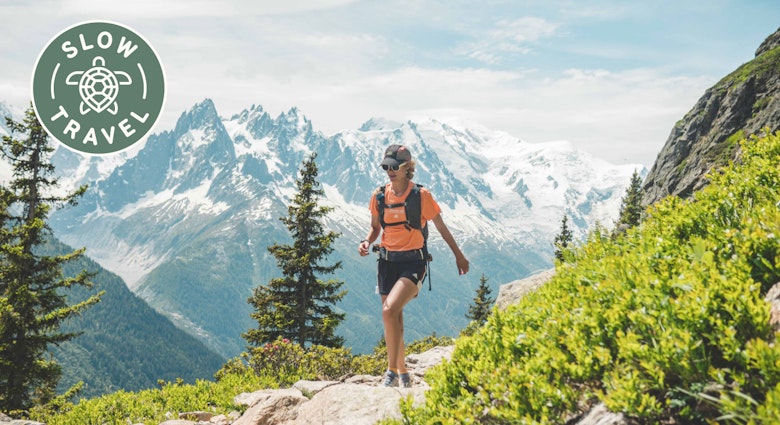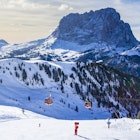
Hiking the Pyrenees: traversing the Tour du Canigou
Dec 5, 2019 • 6 min read

Trying not to look down, my father and I clambered up a steep rocky chimney to the peak of Mt Canigou, to be greeted by a view of the glittering Mediterranean, 50km in the distance. We were at the highest point of the Tour du Canigou, a little known circuit of a spectacular Catalan mountain in the east of the French Pyrenees. Behind us stretched the rest of the Pyrenees mountain range, and below were villages tucked into folds of France and Spain.
Covering just over 15km per day for five days (you can also choose a four day variant), the Tour du Canigou takes walkers around and over the iconic mountain, the final large peak in the Pyrenees before the sea. A big pull of the tour is its remoteness, but the trip also offers varied flora and fauna, a chance to experience the region’s rich Catalan and French history, plus tasty food and affordable accommodation.

Setting off
We started our tour at Batère refuge on the eastern side of the tour. The hostel is in a mostly-empty large block, once home to workers from now disused iron mines. Arriving in the afternoon, we ate a large lunch of fondue and sausage and napped in the functional rooms. In the evening, we shared a meal with other walkers, exchanging our hiking routes in various directions, before getting an early night. Most beds are in shared dorms, though private rooms are available. In the early summer, there are very few visitors so you may get a dorm to yourself.
We made early starts to finish walking before the hottest part of the day, which can mean beautiful light as the sun comes up. At 7am, after a breakfast of bread and coffee, we hauled on our packs and departed. We set off downhill through grass, before climbing on a woodland path. Horses swished their tails at the top of one hill.

In the mountains
We spent the day going deeper into the mountains, climbing and traversing ridges around the eastern slopes of the Canigou massif. At the end of the day, we arrived at the St Guillem hostel, which sits in a verdant valley. The hostel manager made us a tasty lunch and talked of her plans to set up a business transporting packs for walkers on the Tour du Canigou – a service which currently doesn’t exist. We bought packed lunches from the hostel to eat the next day.
Woken by a fierce thunderstorm, we waited for the rain to stop before heading up the valley. This was perhaps the most nature filled day. We saw a salamander sitting on the still damp ground and, further up, wild boars could be heard in the woods. A herd of Isard (the Pyrenean version of chamois goats) ran silently across our path, and later, as we crossed a stream, they came out into the open as they headed up the mountain.
At this point it is possible to go directly to Mariailles, as advertised on local maps and websites, but we had opted to add another day to the trip and go to Las Conques refuge in La Preste – which is only open on Friday and Saturday nights. We arrived at midday to find that the manager would only arrive at 4pm. When he arrived in his van from Spain, he lit a fire and we had warm showers.
The next morning we had a steep climb onto a ridge. At the top, cloud suddenly came in, and we walked through exciting low visibility and wind to the Mariailles refuge. There we wrote in our journals, and listened as large party of Catalans camping nearby came to the refuge for dinner. We looked out of the window and could see the mountain through gaps in the cloud. There was no wi-fi and intermittent phone signal throughout the trip, which meant evenings were spent talking, reading, or going to bed early.

Reaching the peak
We left early in the morning to reach the summit, and were lucky to get a clear day. While the mapped Tour du Canigou goes around the peak of Canigou, most walkers opt to go to the top of the mountain on a well marked route. Patches of melting snow lay in a wide valley leading up to the peak. Towards the top, the route wound back and forth on a path through scree, culminating in the steep chimney. There we had to use our hands as well as feet to climb, and our bags felt heavier than usual.
At the top there's a spectacular 360-degree view of the whole range. The mountain has a cultural significance for the Catalan people, and there's a striking metal crucifix at the top, which keeps guard all year round. On our trip, a pyre was slowly being built, with each piece of wood brought up by walkers, ready to be set alight to celebrate the festival of St John on Midsummer evening (23 June). After taking some pictures – to the tune of faint violin music being played by a patriotic day-tripper – we set off down a gentle slope for lunch at the next refuge.

End of the tour
At the foot of Canigou is the large Cortalets refuge, where we drank beers and looked out at the sea, having nearly completed our journey. Cortalets is accessible by car so it is much busier with walkers, and is an imposing building. The next day we set off on an easier day back to Batère, where we had begun, on the GR10 – a huge trail running along the Pyrenees from the Atlantic to the Mediterranean.
Trip stats
Distance: around 85km
Duration: 5 days
Max altitude: 2784m (an average 900m of climbing and descending each day)
Price for each hostel: around £40 per person per night for food and board.
When to go: June – the snow has gone, the days are long and refuges have opened for the season but aren't crowded. It's possible in all of the summer months.

Getting there
The stops on the Tour du Canigou are remote, particularly without a car. The number 340 bus runs from Perpignan to Arles-sur-Tech. It takes about an hour and, thanks to local government sponsorship, is only €1. To get to the first stop on the route, walk from Arles-sur-Tech to Batère, which takes four hours. On your way back you will go downhill from Batère to Arles, which renders it a potential pitstop for the final day of the tour. If you’d prefer to take the scenic route, you can rest in Batère for a day, then walk for four more days to Banyuls-sur-Mer on the coast.
Explore related stories



 CyclingHow to plan a biking trip to New Zealand’s Southern Lakes and Central Otago regions
CyclingHow to plan a biking trip to New Zealand’s Southern Lakes and Central Otago regionsNov 11, 2024 • 4 min read






